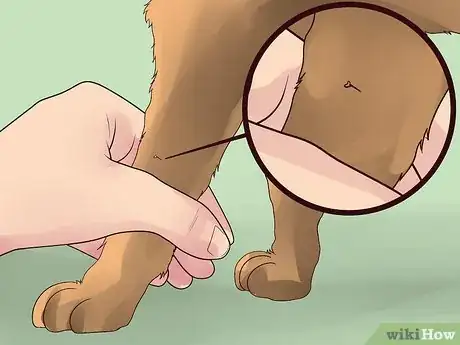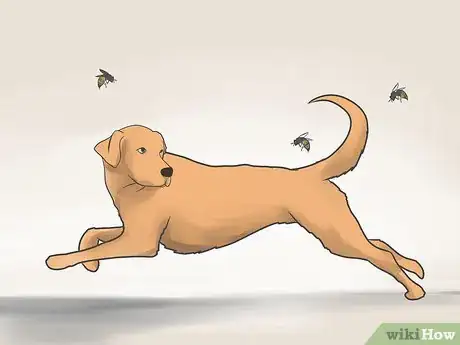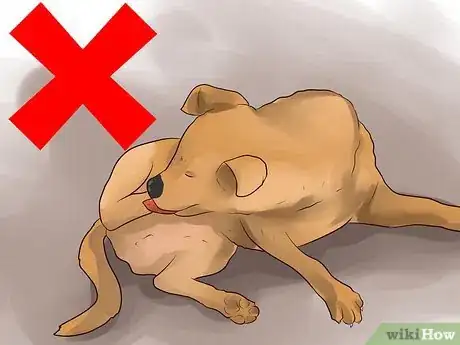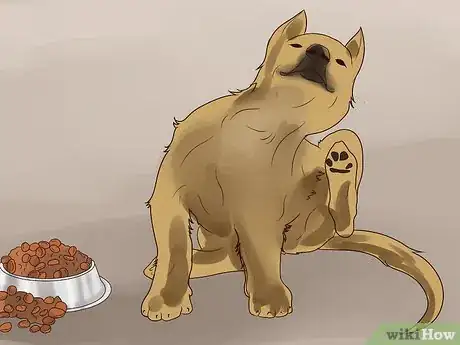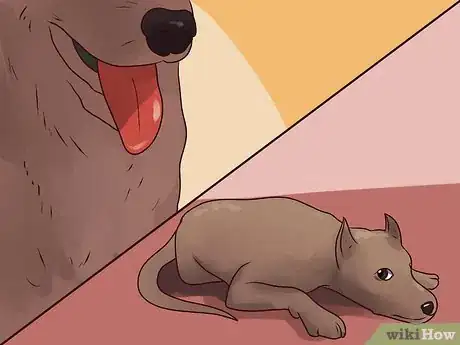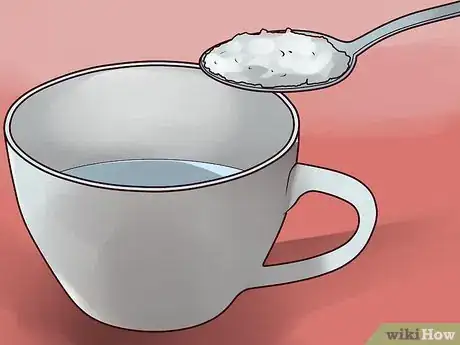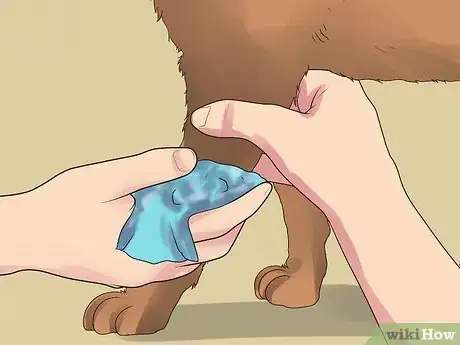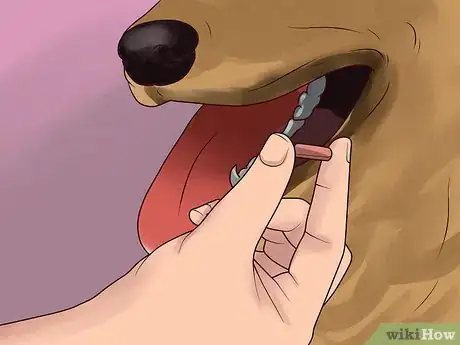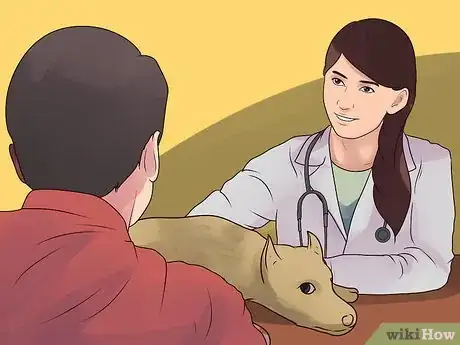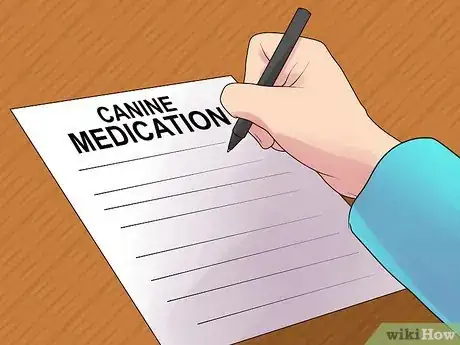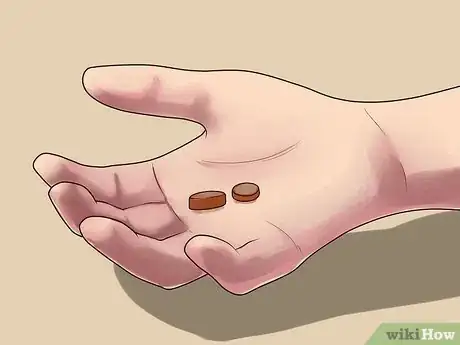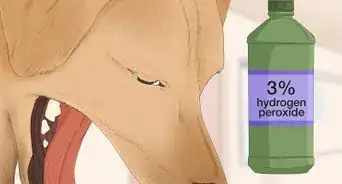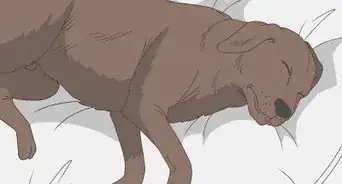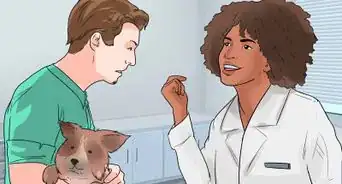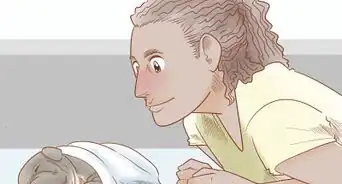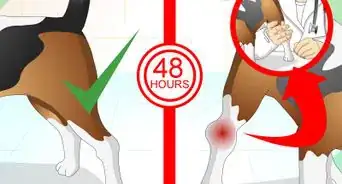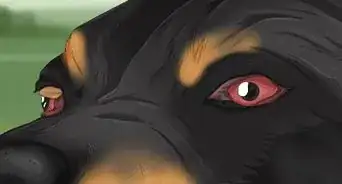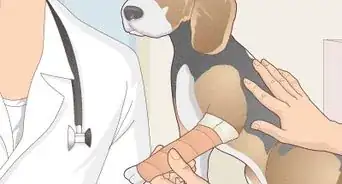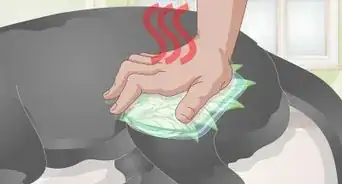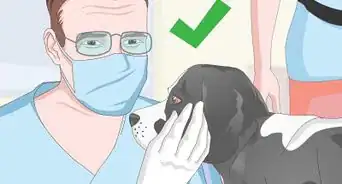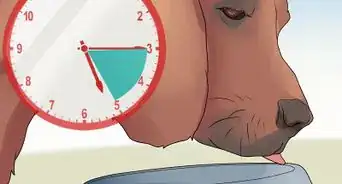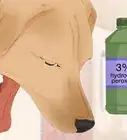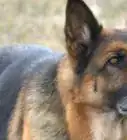This article was co-authored by Pippa Elliott, MRCVS. Dr. Elliott, BVMS, MRCVS is a veterinarian with over 30 years of experience in veterinary surgery and companion animal practice. She graduated from the University of Glasgow in 1987 with a degree in veterinary medicine and surgery. She has worked at the same animal clinic in her hometown for over 20 years.
This article has been viewed 31,175 times.
Most dogs are playful by nature and the temptation to bat at a low-flying bee can be too much to resist. Bee stings are a common problem for our canine companions, with the riskiest time being the autumn as temperatures fall and the bees are sleepy. An irate bee once pounced upon, has not choice but to unleash his stinger.
Steps
Recognizing a Bee Sting
-
1Look for a stinger in the wound area. Each individual bee can only sting once because when he stings something, he embeds the stinger in his victim. This means that if your pet is stung by a bee, you will most likely be able to see a stinger sticking out of his skin.[1]
- The stinger looks like a small barb, or thorn, and may have a blob of fleshy tissue at the end of it (this is where is was attached to the bee’s abdomen). The stinger contains toxins that can irritate the skin and cause pain and swelling.
- If you can pick the stinger out right away, your dog is likely to experience less pain and swelling. This is because the stinger continues to pump toxins into the area long after the sting has occurred.
-
2Listen for a yelp. If your dog was playing with an insect in the yard and suddenly yelps loudly for no apparent reason, there is a good chance that he has been stung. Along with the yelp, he may also appear cowed, meaning he has his tail between his legs and his ears are down.
- Quickly look around the yard to see if there is anything else your dog could have hurt himself on. Look for snakes, sharp rocks on the ground, and objects that could have cut him.
- Check your dog to see if he has any injuries, such as a lame leg or a cut. If you can’t find any dangerous objects and your dog doesn’t have any outright injuries, there is a good chance he was stung by an insect.
Advertisement -
3Try to keep your dog from licking the area. If you see your dog beginning to lick a certain area, stop him so that you can look for a stinger to confirm your suspicions.
-
4Look for the signs of a typical reaction. Bee stings generally cause pain and swelling in the area where they occur. If your dog is able to scratch the area, this will cause further swelling. Other things to look for include[2] :
- A pin-prick sized red spot, surrounded by reddened skin.
- Puffiness in the area.
- Your dog may try to bite or scratch the area because be stings can be itchy.
- If your dog has been stung on an area where the skin does not have much stretch (such as on the bridge of the nose), then the area may become puffy and swollen.
-
5Watch for signs of an anaphylactic reaction. An anaphylactic reaction means that your dog is allergic to bees and the toxins that their stingers contain. Anaphylactic reactions cause a shock-like collapse of the circulatory system and are not so much an external (skin) reaction as an internal one. Anaphylaxis is an emergency situation that requires immediate veterinary attention. Signs to look for include[3] :
- Your dog becomes groggy and wobbly, as if he is drunk or very tired.
- He may seem weak, and might even collapse on the ground. He may also have a hard time lifting his head.
- Your dog’s breathing may become rapid and shallow.
- Look at your dog’s gums. If they appear pale pink or white, rather than a healthy pink like the color of your own gums, then he may be having an allergic reaction.
- Press your dog’s gums with your fingertip. Remove your finger and watch the color come back into the gums. A healthy circulation pumps blood back into the area instantaneously, whereas a dog with slow circulation because of shock will not have color return to his gums for two seconds or more.
Treating a Standard Bee Sting
-
1Remove the stinger if you can see it. To do this, flick it off the skin using a fingernail or the edge of a credit card. There is a slight chance of squeezing more irritants into the skin if you grip the stinger in order to pull it out of your dog’s skin.
-
2Bath the puncture site with baking soda. Bee stings are slightly acidic so the irritant can be neutralized by the application of a little baking soda. There is no exact formula for how much to apply.[4]
- Simply add a teaspoon of baking soda into a cup of water. Soak a cotton wool ball in the solution, and hold this over the sting site for one to two minutes.
-
3Apply a cold compress to the area. Applying a cold compress to the area can help to minimize swelling. You can improvise a cold compress by using anything from a packet of frozen peas to some ice cubes in a plastic bag.
- Hold the cold compress over the site of the sting for five to ten minutes. Remove the compress and, if necessary, repeat again around a quarter of an hour later.
-
4Give your dog antihistamines. Antihistamine may be effective in some dogs, while it does nothing for others. There is no harm in giving your dog an antihistamine, so you may as well try. The antihistamine is intended to stop further swelling, and potentially reduce the swelling that has already occurred. However, there are some things to keep in mind:
- Many over-the-counter antihistamines are suitable for dogs, but never use combined products, such as cold and flu relief product that happens to contain an antihistamine. The other active ingredients may not be safe for your dog.
- One typical antihistamine is diphenhydramine (Benadryl). The dose is 12.5mg (equivalent to a child's strength Benadryl) per 10 to 15 kg body weight. Thus a typical Labrador requires two tablets.[5]
- If your pet has other health problems (especially heart disease or seizures) speak to your vet before administering antihistamines, as diphenhydramine can increase blood pressure in some rare cases.[6]
- Another non-prescription antihistamine is cetirizine (Zyrtec). This is particularly effective against allergic skin disease, and may help a particularly itchy dog. The dose is one 5 mg tablet twice a day (per 15kg body weight).[7]
Dealing with an Anaphylactic Reaction
-
1Bring your dog to the vet immediately if you recognize signs of anaphylactic shock. If you dog gets a bee sting and then collapses, he is most likely having an anaphylactic reaction that requires urgent veterinary care. Remove the stinger and take your pet to the vet immediately.
- The faster you get to the vet’s office, the more likely it is that your dog will be able to absorb the drugs the vet will give him.
-
2Get medication for your dog. The vet may either give your dog an intravenous antihistamine injection, or intravenous steroids in order to suppress the allergic reaction.
- A dog in shock may also need intravenous fluids in order to support his circulation and prevent organ damage.
-
3Try to manage the situation until your dog can be brought to a vet, or a vet can arrive. If you do not live within traveling distance of a vet, then give your dog an antihistamine tablet (as described in the previous section) and keep your dog as warm as possible.
- However, it is important to keep in mind that there is a high risk that your dog will go into shock, which could potentially lead to death. Because of this, it is very important that you try to get your dog veterinary help.
Expert Q&A
-
QuestionHow do you know if your dog was stung?
 Pippa Elliott, MRCVSDr. Elliott, BVMS, MRCVS is a veterinarian with over 30 years of experience in veterinary surgery and companion animal practice. She graduated from the University of Glasgow in 1987 with a degree in veterinary medicine and surgery. She has worked at the same animal clinic in her hometown for over 20 years.
Pippa Elliott, MRCVSDr. Elliott, BVMS, MRCVS is a veterinarian with over 30 years of experience in veterinary surgery and companion animal practice. She graduated from the University of Glasgow in 1987 with a degree in veterinary medicine and surgery. She has worked at the same animal clinic in her hometown for over 20 years.
Veterinarian The best way to be sure your dog was stung is to find the bee stinger embedded in your dog's skin, which is the "smoking gun." You might also see slight swelling around the area of the sting. If you're still not sure, consider the time of year, as bees are most active during spring and summer. Similarly, notice if you've seen a lot of bees flying at ground level, which increases the risk of your dog getting stung.
The best way to be sure your dog was stung is to find the bee stinger embedded in your dog's skin, which is the "smoking gun." You might also see slight swelling around the area of the sting. If you're still not sure, consider the time of year, as bees are most active during spring and summer. Similarly, notice if you've seen a lot of bees flying at ground level, which increases the risk of your dog getting stung.
Warnings
- If you see signs of anaphylactic shock, bring your dog to the vet immediately.⧼thumbs_response⧽
References
- ↑ Hymenoptera stings. Fitzgerald & Flood. Clin Tech Small Anim Pract 21, p194-204
- ↑ Insect hypersensitivity in small animals. Friberg & Lewis. Comp Contin Educ Pract Vet 29 (10),p 1121-1131
- ↑ Insect hypersensitivity in small animals. Friberg & Lewis. Comp Contin Educ Pract Vet 29 (10),p 1121-1131
- ↑ Hymenoptera stings. Fitzgerald & Flood. Clin Tech Small Anim Pract 21, p194-204
- ↑ Diphenhydramine. Plumb's Veterinary Drug Handbook. Donald Plumb. Publisher PharmaVet
- ↑ Diphenhydramine. Plumb's Veterinary Drug Handbook. Donald Plumb. Publisher PharmaVet
- ↑ Cetirizine. Plumb's Veterinary Drug Handbook. Donald Plumb. Publisher PharmaVet
About This Article
To treat a dog for bee stings, start by flicking the stingers off of your dog's skin if you're able to see them. Avoid gripping the ends of the stingers since it could squeeze out more irritants. Next, soak a cotton ball in baking soda and water, and hold it over the sting site for 1-2 minutes to help alleviate the pain. You can also apply a cold compress to the area for 5-10 minutes to reduce swelling. If your dog shows signs of going into anaphylactic shock, like collapsing, take it to a vet immediately. To learn how to tell if your dog has been stung by bees, keep reading.
